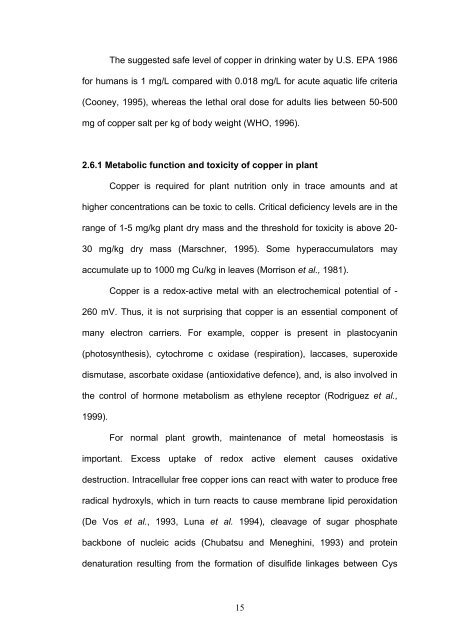IDENTIFICATION OF COPPER-INDUCIBLE GENES IN Pistia stratiotes
IDENTIFICATION OF COPPER-INDUCIBLE GENES IN Pistia stratiotes
IDENTIFICATION OF COPPER-INDUCIBLE GENES IN Pistia stratiotes
You also want an ePaper? Increase the reach of your titles
YUMPU automatically turns print PDFs into web optimized ePapers that Google loves.
The suggested safe level of copper in drinking water by U.S. EPA 1986<br />
for humans is 1 mg/L compared with 0.018 mg/L for acute aquatic life criteria<br />
(Cooney, 1995), whereas the lethal oral dose for adults lies between 50-500<br />
mg of copper salt per kg of body weight (WHO, 1996).<br />
2.6.1 Metabolic function and toxicity of copper in plant<br />
Copper is required for plant nutrition only in trace amounts and at<br />
higher concentrations can be toxic to cells. Critical deficiency levels are in the<br />
range of 1-5 mg/kg plant dry mass and the threshold for toxicity is above 20-<br />
30 mg/kg dry mass (Marschner, 1995). Some hyperaccumulators may<br />
accumulate up to 1000 mg Cu/kg in leaves (Morrison et al., 1981).<br />
Copper is a redox-active metal with an electrochemical potential of -<br />
260 mV. Thus, it is not surprising that copper is an essential component of<br />
many electron carriers. For example, copper is present in plastocyanin<br />
(photosynthesis), cytochrome c oxidase (respiration), laccases, superoxide<br />
dismutase, ascorbate oxidase (antioxidative defence), and, is also involved in<br />
the control of hormone metabolism as ethylene receptor (Rodriguez et al.,<br />
1999).<br />
For normal plant growth, maintenance of metal homeostasis is<br />
important. Excess uptake of redox active element causes oxidative<br />
destruction. Intracellular free copper ions can react with water to produce free<br />
radical hydroxyls, which in turn reacts to cause membrane lipid peroxidation<br />
(De Vos et al., 1993, Luna et al. 1994), cleavage of sugar phosphate<br />
backbone of nucleic acids (Chubatsu and Meneghini, 1993) and protein<br />
denaturation resulting from the formation of disulfide linkages between Cys<br />
15








![[Consumer Behaviour] - ePrints@USM](https://img.yumpu.com/21924816/1/184x260/consumer-behaviour-eprintsusm.jpg?quality=85)








